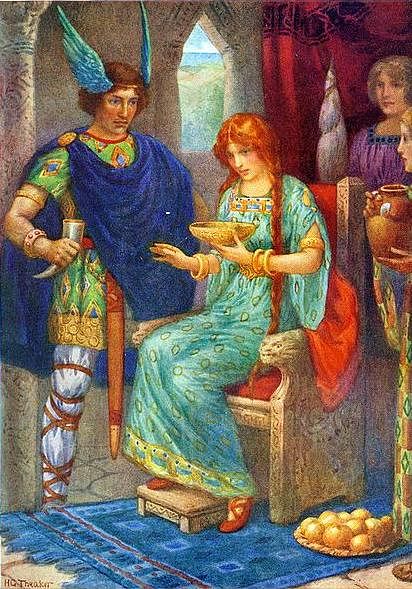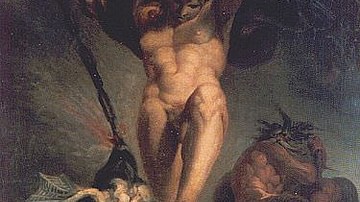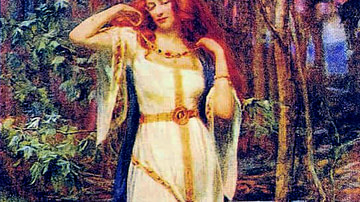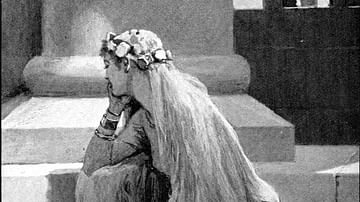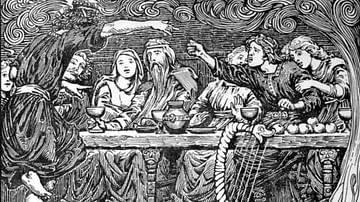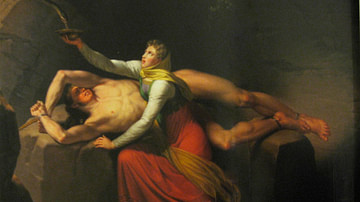
Freyr (Old Norse for 'Lord', sometimes anglicised as Frey) is the main fertility god in Norse mythology, his connection with harvests, sun and rain, virility, weddings, and his rule over wealth securing him an important position within the predominantly agricultural Viking Age Scandinavian society (c. 790-1100 CE). This makes him the most prominent god of the Vanir family (the other family being the Æsir). Freyr's link with fertility is not just of a personal nature but is very much connected to the land and its produce, too, which helps explain why there is such ample evidence of a cult of Freyr. Son of Njord and twin brother of Freyja, Freyr overshadows both of these fellow Vanir gods when it comes to evidence of active worship; many place names bear his mark, and sacrifices and devotion ring out loud and clear from both the literature and the archaeological record, especially pertaining to Sweden. With his alternate name Yngvi-Freyr, he was even seen as the mythical ancestor of the Swedish royal dynasty of the Ynglings.
In the Norse pantheon, Freyr is married to the giant-daughter Gerðr, with whom he has a son, Fjölnir, and he is famously accompanied by a boar (sometimes depicted as a golden boar and named Gullinborsti) and also owns the highly useful ship Skíðblaðnir. A more versatile god than he would seem at first glance, Freyr's abilities also reach beyond the domain of fertility and extend to the battlefield; myths describe his military prowess, and his death comes in battle with the giant Surtr during the Ragnarök, the final destiny of the gods in which the known world is destroyed.
Family
Freyr belongs to the Vanir, a group of fertility gods who are actually a very closely knit family unit – more so than the much larger Æsir family, whose members are mostly connected with war and government. Other properly attested members are his father, Njord, who rules wind, sea, and wealth, and his twin sister Freyja, who is an expert in matters of love, lust and, following the common thread, wealth, too. The giant-daughter Skadi, who is Njord's wife, is usually seen as the twins' mother. According to the poem Grímnismál which has reached us by way of the Poetic Edda, Freyr lives in Alfheimr, the world of the elves, given to him as a present from the Æsir for the appearance of his first tooth.
The Vanir were probably originally not only close-knit but were tangled altogether, as Freyja is thought to have started off as Freyr's wife in a brother-sister married couple pairing. However, the more well-known version represented in the body of Norse mythology that has reached us has Freyja married to Ódr, and Freyr 'wooing' – but in effect threatening in order to get her to agree to be his wife – the giant-daughter Gerðr.
This story is recorded in the Skírnismál ("lay of Skírnir") known to us from the Poetic Edda which was compiled in c. 1270 CE but contains material that dates back at least as far as the 10th century CE. It describes how Freyr sits atop Odin's high seat and looks all the way into the realm of the giants, Jotunheim, where he spies Gerðr walking through the garden. Love at first sight hits him and promptly sends his servant Skírnir to her to make her a marriage offer, lending him his horse as well as his sword. Skírnir comes well prepared and brings objects with which to win (or bribe) her: eleven golden apples, the ring of Odin, and a staff. Proud Gerðr refuses all of them, after which Skírnir begins a monologue consisting of nothing but terrible threats, beginning with:
Seest thou, maiden, | this keen, bright sword
That I hold here in my hand?
Thy head from thy neck | shall I straightway hew,
If thou wilt not do my will.
(Skírnismál, 23)
She keeps resisting, however, her pride only broken when Skírnir decorates the staff with runes empowered to drive her insane, after which she finally promises Freyr her love. The deeper meaning of this somewhat disconcerting tale is often explained as follows. Gerðr is seen as a goddess of the earth, whose marriage with Freyr who represents the fertilising heavens (or sun) makes for a holy wedding – known in Greek as hieros gamos - which ensures the springtime regeneration of the earth. It is even possible to go a step further and see the myth in a more political way, as an analogy for the conquest of land.
Freyr and Gerðr are certainly productive in that they have a son, Fjölnir, together. This Fjölnir is said to have been a legendary Swedish king – following from Yngvi-Freyr's Yngling connection – and set a very fine example indeed: a tale that is at least as old as the 9th century CE tells of his death that occurred as an unfortunate consequence of him tumbling into a vat of mead while in a drunken stupor at a feast.
Attributes
Freyr is not alone in his godly pursuits but has attributes to accompany him – most commonly the boar and the ship Skíðblaðnir (Old Norse for "assembled from pieces of thin wood"). According to the Icelandic mythographer Snorri Sturluson (1179-1241 CE) – our most comprehensive source with regard to Norse mythology – Freyr's boar companion was called Gullinborsti, "the one with the golden bristles", who pulled his chariot and was able to
…run through air and water better than any horse, and it could never become so dark with night or gloom of the Murky Regions that there should not be sufficient light where he went, such was the glow from its mane and bristles. (Skáldskaparmál, 35)
According to Snorri, Freyr even directly rides this boar to the god Baldr's cremation. Although the mentioned superboar traits are probably courtesy of Snorri's imagination, the boar link itself is likely to be old. Boars were sacrificed in the sonarblót, or sacrifice of the boar, which was held as a harvest blessing from early on, and, as signs of fertility, boars fit in nicely with the Vanir in general. Moreover, already in 986 CE, the Icelandic poet Úlfr Uggason connected the boar directly with Freyr in the Hávamál poem, even mentioning its golden bristles. In Sweden, the boar was adopted by its Ynglinga kings to the extent that they even have a crown jewel connected to it: the ring Svíagríss, "boar of the Swedes". Freyr's boar companion does not crop up very often in literary sources, however.
The ship Skíðblaðnir is likewise thought to have an old origin, since seafaring was part of the Vanir domain, too - especially that of Njord's. It was built by dwarfs and built well, being imbued with nifty powers: all the Æsir plus their weapons are supposed to fit on it, it is always accompanied by a favourable wind propelling it forward, and it can even be conveniently folded up like a napkin and stuffed inside one's pocket.
One of the powerhouses of Germanic mythology, H. R. Ellis Davidson, also adds the horse as an attribute of both Freyr and his sister Freyja. Lastly, our available literary sources hint at the sickle being another one of Freyr's possible attributes, as they are sometimes found attached to rings or pendants and are obviously linked to agriculture.
Function in society
Freyr's foremost function as a Norse god is found in his influence over fertility. Snorri Sturluson describes him as follows:
Freyr is the noblest of the gods; he rules over rain and sunshine and thus over the produce of the earth; it is good to call upon him for good harvests and for peace; he watches over the prosperity of mankind. (Gylfaginning, 23)
During the Viking Age, Scandinavia and other areas under the Vikings' sway relied for a large part on farming, so devotion to fertility gods such as Freyr in order to nudge the farming yields in the right direction makes for an unsurprising element within these societies. High yields would have led to increased wealth, which is another one of Freyr's domains. Besides the agricultural side of fertility, Freyr is also connected with the human side, being invoked when weddings were celebrated as well as having a hand in matters of virility. In representing this specific facet of society - whereas Odin, for instance, was deemed important to rulers, warriors, and poets - Freyr was certainly a highly important god in Viking-Age Scandinavia.
However, Freyr possessed other qualities, too, which bring some versatility to his character and perhaps even his function. Not content to just lounge around his bountiful fields, he is not against getting his hands dirty in battle, either: the Prose Edda (composed c. 1220 CE by Snorri Sturluson) relays how Freyr slays the giant Beli with a stag's antler, his magic sword still in the possession of his servant Skírnir, and how in the Ragnarök he fights the giant Surtr and loses in what was perhaps not the smartest move considering he still did not have his sword.
Nevertheless, other texts attest to his military prowess, calling him the "field-marshal of the gods" (Skírnismál 3), "battle-skilled" and ruler of armies (Húsdrapa), "protector of the Æsir" (Lokasenna 35), attributing him a horse named "Bloodyhoof" and describing him as the "boldest of riders" (Lokasenna 37). Although this is hardly as direct of an association with war as found with the gods Odin and Thor, W. P. Reaves argues that Freyr "is not merely the fertility god of a farming population, but possesses all of the prerequisites of an ideal king: virility, military prowess, and wealth, the attributes required to obtain and keep a throne" (6). Considering Freyr's status as the mythical forefather of the Swedish Yngling dynasty, this might not be too much of a stretch.
Cult of Freyr
With a function closely connected to the basic needs of society, it is not surprising that there is ample evidence of a cult of Freyr. One way to unearth the potential worship of certain deities is by looking at place names containing the god's name, which often indicate where cults may have been practised. For Freyr, places such as Fröslunda ("the grove dedicated to the god Freyr"), Freysaker, Freysland, Freyshof, and Freyslundr (all containing words referring to fields, meadows, etc.) show a distribution concentrated mostly in Norway and Sweden, although Franeker in the Netherlands betrays Freyr's broader Germanic roots.
Sacrifices to Freyr are known from the literature. For instance, there was the previously mentioned sonarblót ("Sonar-sacrifice") in which a boar known as the sonargöltr ("sacrificial boar") was sacrificed to Freyr to ensure good harvests. The poem Helgakviða Hjörvarðssonar and the saga Hervarar saga ok Heiðreks both describe how on the evening of Yule, hands were placed on the back of this boar while an oath was sworn, after which it was killed. The Heimskringla gets a bit more nitty-gritty in its description of a sacrificial feast in Trøndelag, Norway, in the 10th century CE. Animals, mostly horses and pigs, were said to have been killed and cooked while their blood was sprinkled across walls and idols, and participants drank sacred beer and ate the meat, toasting to Odin, Njord, and Freyr to curry favour with them.
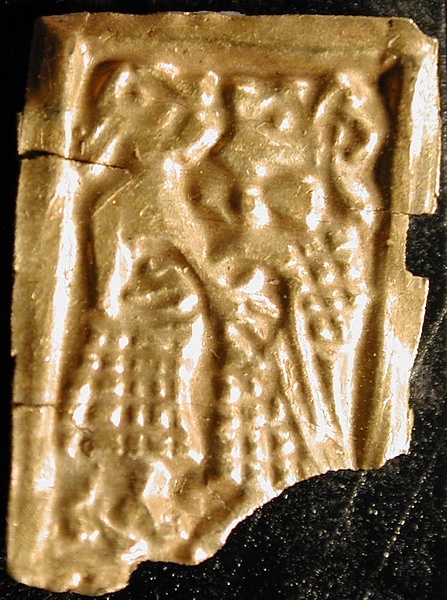
Another Freyr-related sacrifice is the Frøsblot ("Frø-sacrifice", with Frø being another name for Freyr) as recorded by Saxo Grammaticus, a Danish scholar who lived c. 1150-1220 CE. In Uppsala, Sweden, a certain Haddingus is said to have instituted a yearly sacrifice to Freyr – the Frøsblot - as a way of atonement to the god, something seemingly linked to the great sacrifice at Uppsala that is supposed to have happened every nine years.
There may indeed have been a temple at Uppsala, as a famous account – based on hearsay but usually considered reasonably to moderately authentic – written by Adam of Bremen c. 1070 CE argues. Adam writes of a big, golden temple with statues of Thor, Odin, and Fricco (synonymous with Freyr), the latter adorned with an "immense phallus" (4). Every nine years, men, horses and dogs were allegedly sacrificed, their bodies swinging from trees in the sacred grove. The archaeological record does not support the existence of a temple, although there are other buildings among which a large hall have been found dating to between the 3rd and 10th centuries CE. As A. Hultgård explains,
What cannot be questioned…is the importance of the Uppsala festival as a religious and political manifestation, the existence of a sacred grove and a building for ritual community meals, probably a hall (triclinium). Some further details reported by Adam seem likewise to derive from genuine tradition. It was customary to perform various songs during the ritual offerings and some of them were most probably addressed to the god Freyr who, according to Adam, was invoked for weddings and fertility. (Brink and Price, 216)
Devotion to Freyr stretched across the sea, too, as Icelandic historical sources splash out on not just oaths that involve him ("so help me Freyr and Njord and hinn almáttki áss," meaning the almighty god) but even repeatedly mention men known as Freysgoði or priests of Freyr.
The hints given by the place names and literature of widespread and visible cultic activity and devotion to Freyr are given a nice little boost by the archaeological record; artefacts have been found that are often linked to Freyr. The one hardest to ignore is a bronze statuette from Rällinge, Sweden, which is shaped like a bearded man sitting cross-legged and sporting an erect phallus. Other artefacts are tiny gold-foil pictures found in Scandinavia that might depict the holy marriage between Freyr and Gerðr, as well as also miniatures of sickles (a possible attribute of Freyr) and pendants or rings shaped like fire-making tools thought to be connected to fertility cults. All in all, Freyr definitely seems like a useful god to have a hotline connection set up with.

